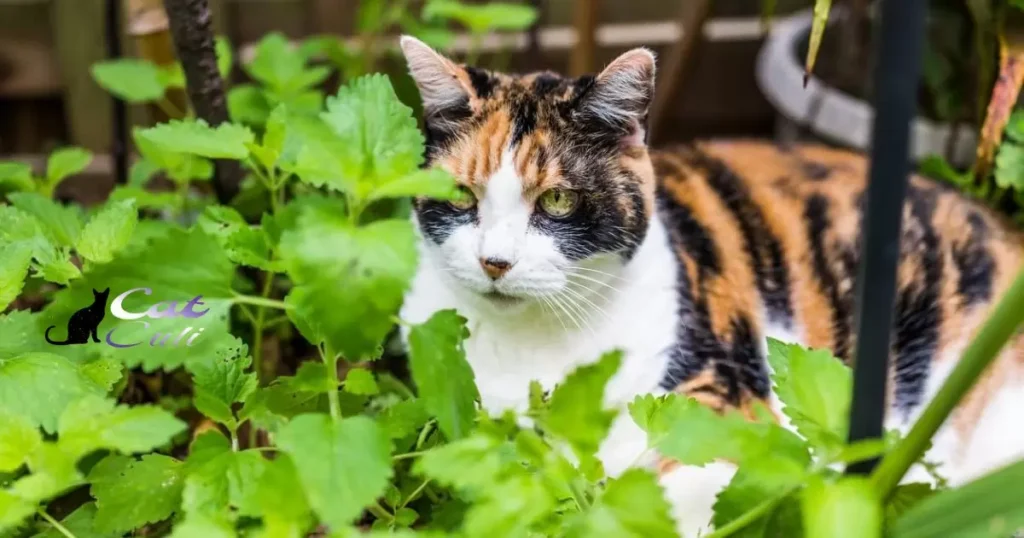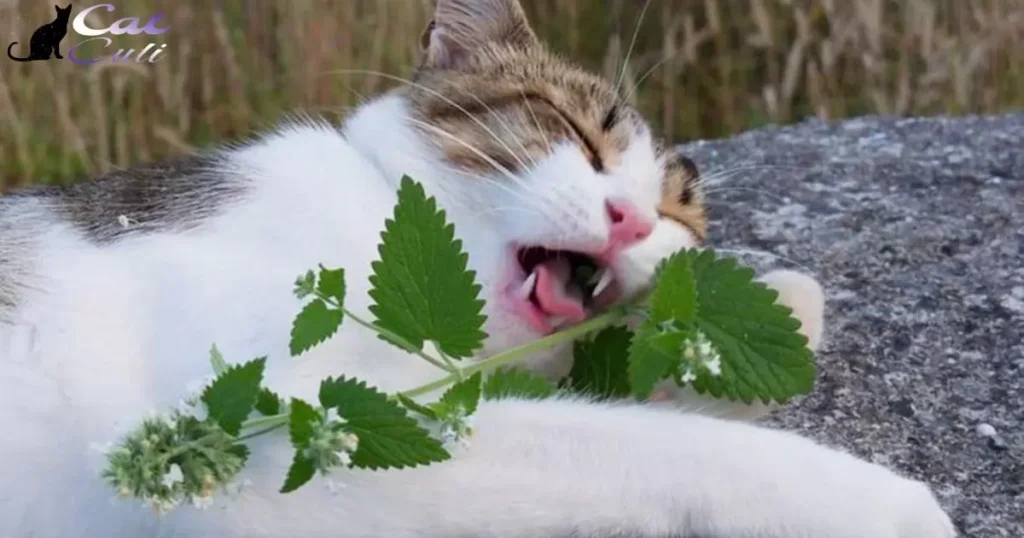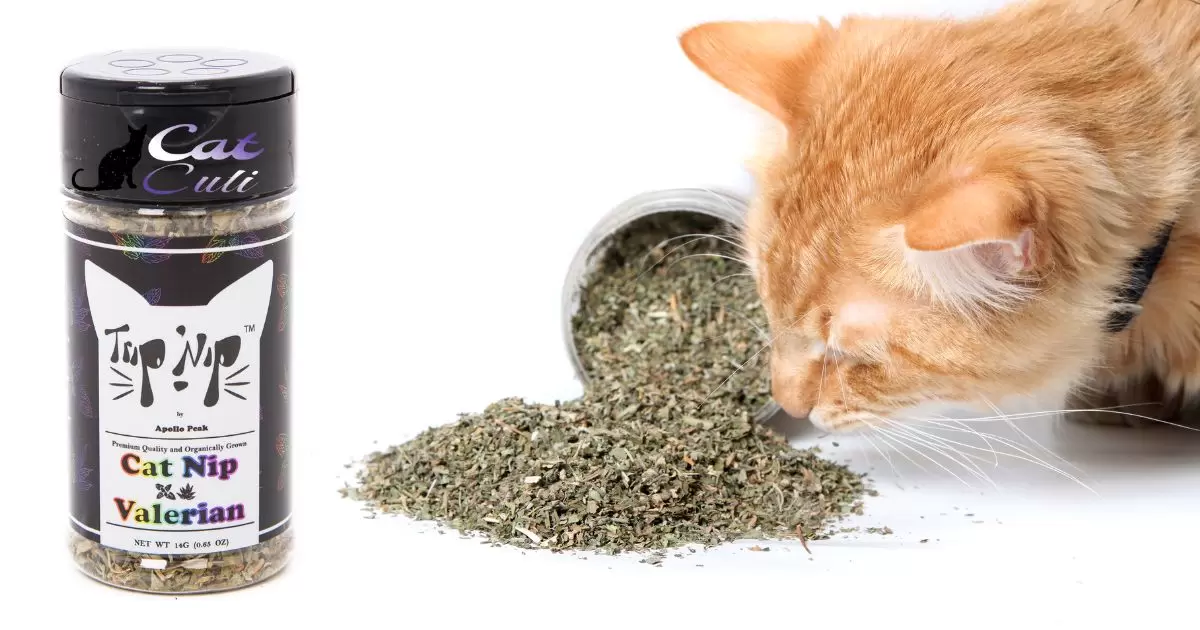Adding catnip to cat food is safe and enjoyable for many cats. Catnip, a herb from the mint family, can be sprinkled in small amounts onto their food. It often elicits playful behaviour and relaxation in cats. Not all cats respond to catnip, so observe your cat’s reaction before making it a regular addition to their meals.
Wondering if you can add catnip to cat food the answer might surprise you. Discover the intriguing world of feline cuisine and whether that sprinkle of catnip could turn your kitty’s mealtime into a delightful adventure. Join us as we explore the possibilities and unravel the mystery behind Can You Add Catnip To Cat Food.
Curious about whether you can add catnip to your cat’s food? Stay with us to uncover the dos and don’ts of introducing this intriguing herb into your feline friend’s diet. We’ll explore the benefits and potential considerations to ensure your cat’s dining experience remains safe and enjoyable.
What Is Catnip?
Catnip is a herb known for its captivating effect on many cats. It belongs to the mint family and contains a compound called nepetalactone, which triggers a unique response in felines. When cats encounter catnip, they often exhibit behaviours like rolling, rubbing, or playful antics, lasting for about 10-15 minutes.
This herb’s allure isn’t universal, as not all cats respond to its effects – it’s estimated that around 50-70% of cats are sensitive to catnip’s charms.This plant is safe for cats and is often used as an enriching tool in their environment.
Owners might introduce catnip via toys, scratching posts, or simply by sprinkling it around. Catnip doesn’t pose any known health risks to cats, and its effects are entirely natural, providing a playful and stimulating experience for many curious feline companions.
Can Cats Eat Catnips?
Catnips are safe for cats to consume in small amounts. They contain a compound called nepetalactone that can trigger a temporary state of excitement or relaxation in most cats. When ingested, catnip often induces playful behaviour or a sense of calm in our feline friends.
Not all cats respond to catnip, with estimates suggesting around 30% are not affected by it at all.It’s important to note that while catnip is non-toxic and generally safe, moderation is key.
Too much catnip might lead to an upset stomach or mild digestive issues in some cats. Always introduce it gradually and observe your cat’s response to ensure they enjoy it without any adverse effects.
How Often Can Your Cat Eat Catnip?
Cats can enjoy catnip a few times a week without any issues. It’s best to keep it in moderation, as overindulgence might lessen its effects over time. Introducing catnip to your cat’s playtime or using it as an occasional treat can keep its allure intact.
Observing your cat’s response is crucial; not all cats react the same way to catnip. Some might become more playful or relaxed, while others might show no interest at all. Keeping it occasional ensures your cat continues to enjoy the stimulating effects without losing interest.
How Long Do The Effects Of Catnip Last?
- Catnip’s effects typically last around 10-15 minutes in most cats.
- After this initial period, cats may become temporarily immune to its effects for about 1-2 hours.
- Sensitivity to catnip varies among individual cats, with some showing stronger reactions than others.
- Young kittens and older cats might not respond to catnip as strongly as adult cats do.
- The duration and intensity of the effects can differ between sniffing, chewing, or ingesting catnip.
- Overuse of catnip might diminish its effects over time, so moderation is key for sustained enjoyment.
My Cat Doesn’t Respond To Catnips Is Something Wrong?
If your cat doesn’t respond to catnip, it’s completely normal! Not all cats are affected by catnip – it’s estimated that around 30% to 50% of cats don’t react to it at all. It’s not a cause for concern; some cats simply lack the genetic sensitivity to the compounds in catnip that trigger a response.
The absence of interest in catnip isn’t a concern for your cat’s health. It’s genetic. Just like how chickens eat hard cat food without issues, some cats simply don’t react to catnip, and that’s perfectly normal.
Ways To Offer Catnip To Your Cat

There are a few ways to offer catnip to your cat. You can sprinkle dried catnip on the floor or a scratching post, encouraging playful interactions. Another option is using catnip-infused toys, letting your cat enjoy the herb while engaging in active play.
Offering fresh catnip leaves from a plant also entices some cats, allowing them to sniff, chew, or rub against the leaves for a natural sensory experience.
Consider incorporating catnip into DIY toys or stuffing it inside fabric pouches for an interactive and stimulating play session. Moderation is key, ensuring your cat enjoys the effects without overwhelming their senses.
How To Choose The Right Animal Hospital
Selecting the right animal hospital involves considering various factors. Firstly, assess the hospital’s proximity to your home—opt for a location that’s easily accessible during emergencies.
Secondly, check their services and facilities to ensure they meet your pet’s needs, from routine check-ups to specialized care. Finally, look for reviews or ask for recommendations from trusted sources to gauge the hospital’s reputation and the quality of care they provide.
When choosing an animal hospital, prioritize your pet’s comfort and well-being. Visit the facility beforehand to observe cleanliness, staff interactions, and overall atmosphere. Inquire about the qualifications and experience of the veterinarians to ensure your furry companion receives the best possible care in a welcoming and reliable environment.
Can Dogs Really Sneeze?
Dogs can indeed sneeze, just like humans. Sneezing in dogs serves various purposes, from clearing out irritants in their nasal passages to signaling playfulness or even as a response to excitement.
When dogs sneeze, it’s often a natural and healthy reflex, much like it is for us.Their sneezes can be caused by dust, pollen, or even foreign objects that may have entered their noses during exploration.
Sometimes, sneezing in dogs can also be a reaction to certain scents or fragrances, reflecting their sensitive olfactory senses. So, if you’ve noticed your furry friend sneezing, it’s usually a normal part of their daily routine and nothing to worry about.
Your Pet Deserves The Best Care
Your pet thrives with the best care. Ensuring their well-being involves regular check-ups, a balanced diet, and plenty of love and attention. From walks in the park to cozy cuddles at home, providing the best care means creating a happy, healthy environment for your furry companion.
Investing in your pet’s health brings joy and companionship. Regular grooming, interactive playtime, and quality nutrition are essential components of top-notch pet care. By prioritizing their needs and keeping them safe and content, you create a bond that enriches both your life and theirs.
Is It Ok To Mix Catnips In Cat Food?
Mixing catnip in cat food is generally safe and enjoyable for many feline friends. Cats often respond positively to the addition of a small amount of catnip sprinkled into their food. It’s essential to observe your cat’s reaction as not all cats are responsive to catnip.
Introduce it gradually to gauge their interest and ensure it doesn’t cause any adverse effects on your furry companion.Adding catnip to cat food can elicit playful behaviour and relaxation in responsive cats.
It’s a simple way to enhance their mealtime experience and add a touch of excitement to their day. Just remember to use it in moderation and monitor how your cat responds to ensure they benefit from this herbal addition.
The Magic Of Catnip In Feline Meals

Catnip, a herb in the mint family, works wonders in enticing many cats. Adding a sprinkle to their food can create excitement and relaxation. Cats often exhibit playful behaviour and contentment when they encounter catnip-infused meals, making it a magical addition to their dining experience.
This herb’s allure lies in its ability to stimulate cats’ senses without any harm. When integrated into their meals, catnip can trigger a range of reactions, from playful antics to serene relaxation. Incorporating catnip into feline meals adds an enchanting touch that captivates and delights our beloved furry companions.
Is It Safe To Put Catnips In Cat Food?
Adding catnip to cat food is generally safe for most feline friends. The herb, known for its enticing effects on cats, can be a playful addition to their meals. It’s essential to introduce it gradually and in small amounts to monitor your cat’s reaction and ensure they enjoy it without any adverse effects.
Observing your cat’s response to catnip in their food is crucial. Some cats might not react or may even show signs of sensitivity. Keeping an eye on their behaviour after consumption helps determine if it’s safe and enjoyable for your furry companion.
Can I Give My Cat Catnip Every Day?
Sure, giving your cat catnip every day isn’t recommended. While catnip is safe and non-addictive, its effects tend to diminish with frequent use. Introducing catnip sparingly, say once or twice a week, maintains its potency, preventing your cat from becoming desensitized to its allure.
Overexposure to catnip can lessen its impact on your furry friend, reducing their responsiveness over time. To keep the experience enjoyable for your cat, moderation is key when offering catnip, ensuring they continue to find it engaging and entertaining without losing interest.
What Are The Benefits Of Catnip For Cats?
- Behavioural Enrichment: Catnip can stimulate cats’ playfulness and activity levels, providing mental and physical exercise.
- Stress Reduction: It may aid in alleviating stress and anxiety in some cats, promoting relaxation and calmness.
- Environmental Enrichment: Catnip can enhance environmental exploration, encouraging cats to interact more with their surroundings.
- Training Aid: It can be used as a tool in training or encouraging positive behaviours, making it easier to redirect attention or encourage activity.
Is Catnip Safe For Kittens?
Catnip is generally safe for kittens. It’s a herb that induces playful behavior in many cats but isn’t harmful. Kittens usually don’t respond to catnip until they’re a few months old. Supervising their initial interactions with catnip ensures they don’t consume too much too quickly.
Introducing catnip gradually to kittens can be a fun experience. It’s best to wait until they’re around three to six months old. Monitoring their reactions allows you to gauge their sensitivity to it, ensuring a safe and enjoyable introduction to this herb.
When Can You Give Your Cat Catnip?
You can introduce catnip to your cat once they reach six months old. Before that age, cats usually don’t react to it. When offering catnip, ensure it’s in moderation, typically a pinch or small amount.
Observing their behaviour some cats might get hyperactive, while others become more relaxed. Always watch for any adverse reactions and avoid giving catnip too frequently.
Not all cats respond to catnip—about 50% don’t react to it at all. Also, give breaks between catnip sessions to prevent your cat from becoming desensitized to its effects. It’s a fun treat, but moderation and understanding your cat’s reaction are key to a happy catnip experience.
Is Meowijuana Safe For Cats?

Meowijuana, a brand of catnip, is generally safe for cats when used appropriately. It’s a cat-friendly herb that can induce playful behaviour and relaxation in most feline friends. Like any product, moderation is key to ensure your cat enjoys it without any adverse effects.
Observing your cat’s reaction to Meowijuana and using it in small amounts can ensure a safe and enjoyable experience for your pet.Before introducing Meowijuana to your cat, consulting with your veterinarian can provide helpful guidance.
They can advise on the appropriate dosage and frequency based on your cat’s health and individual needs. Monitoring your cat’s response to Meowijuana helps ensure a positive and safe experience, letting your furry friend have a purr-fectly delightful time without any worries.
Are Cats Supposed To Eat Catnip Or Just Smell It
Cats aren’t meant to eat catnip; they typically just smell or interact with it. Eating catnip isn’t harmful, but it might result in an upset stomach. When cats smell catnip, it triggers a response in their brains, making them playful or relaxed. They might roll around, paw at it, or just enjoy the scent without consuming it.
If your cat eats a bit of catnip, there’s usually no cause for concern. However, it’s best to limit their ingestion to avoid potential digestive issues. Encourage them to interact with catnip through play or sniffing rather than consuming large amounts, keeping their catnip experience safe and enjoyable.
Can I Put Catnip In My Cats Water
Adding catnip to your cat’s water is safe and can be enticing for some felines. Simply sprinkle a small amount of dried catnip into their water dish to see if your cat enjoys the infused water.
Not all cats are responsive to catnip, so observe your cat’s reaction to ensure they find it appealing. It’s an easy and harmless way to add a bit of fun to their hydration routine!Ensure you monitor your cat’s intake as some may prefer their water without catnip.
If your cat shows no interest or avoids the water, it might be best to offer plain water separately. Experimenting with small amounts can help you gauge your cat’s preference without overwhelming their drinking routine.
Can Cats Eat Dried Catnip
Yes, cats can safely eat dried catnip. Dried catnip, often available in stores, can be given to cats in small quantities as a treat. It’s known to induce playful behaviour in most cats and is perfectly fine for them to consume.
Just remember, moderation is key to ensure it doesn’t overwhelm your furry friend. Offering a pinch of dried catnip occasionally can bring joy to your cat without any harm. When considering giving your cat dried catnip, remember to observe their reaction.
Not all cats are responsive to catnip, so it’s essential to see if your feline enjoys it. It’s also advisable to store catnip properly in an airtight container to maintain its potency and freshness for your cat’s future enjoyment.
Side Effects Of Catnip On Cats
Catnip can provoke various reactions in cats, like excitement or relaxation. Some may get hyperactive, while others become calm. Excessive consumption might lead to vomiting or diarrhoea in a few sensitive cats.
It’s essential to monitor your cat’s response to catnip and offer it in moderation to avoid potential digestive issues.Not all cats are affected by catnip, as sensitivity varies among individuals.
For those who do react, the effects usually last around 10-15 minutes before fading away. Keeping an eye on your cat’s behaviour after exposure to catnip can help you gauge their tolerance and prevent any adverse reactions.
Is Catnip Good For Cats Digestion

Catnip can aid a cat’s digestion by promoting relaxation, which may help soothe an upset stomach. It can encourage a cat to relax, potentially reducing stress-related digestive issues.
Some cats might exhibit increased appetite after exposure to catnip, leading to better digestion due to increased food intake. Individual cat responses to catnip vary, so observe your cat’s reaction before making it a regular part of their diet to ensure it benefits their digestion.
FAQ’s
Is it okay to put catnip in my cat’s food?
Yes, it’s safe, but in moderation. Start with a pinch, gradually increasing if your cat enjoys it.
How much catnip should I put in my cat’s food?
Begin with a small pinch, about 1/8 to 1/4 teaspoon, and adjust based on your cat’s response.
Can cats have catnip while feeding?
Yes, but consider offering it separately from their mealtime to prevent distraction or loss of appetite.
How do you feed catnip to cats?
Sprinkle it over their food or offer it in a separate area, observing their reaction for enjoyment.
Conclusion
In conclusion, Can You Add Catnip To Cat Food? Yes, it’s generally safe and can add a playful touch to your cat’s dining experience. Start with small amounts and observe your cat’s response before making it a routine addition. While some cats adore catnip’s effects, others might not show much interest.
It’s crucial to respect individual preferences. Whether sprinkled on their food or offered separately, catnip can be a delightful treat for many feline friends, but always in moderation to ensure a purr-fectly enjoyable mealtime.








